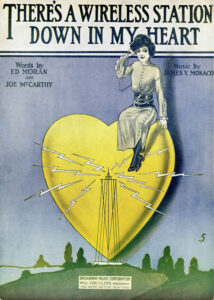Service update
- MIT community members and non-MIT users must request an appointment to visit our reading room and request materials at least 4 business days in advance. See: Hours
- We offer virtual reference consultations with materials from our collections and provide digitization services.
- Requests from the MIT community will continue to be prioritized. Thank you for your patience and understanding.
Distinctive Collections collects, preserves, and fosters the use of unique and rare materials such as tangible and digital archives, manuscripts, ephemera, artists’ books, and more. With these collections the Libraries seek to cultivate an interest in the past, present, and future; the humanistic and the scientific; and the physical and the digital in order to inspire and enable research, learning, experimentation, and play for a diverse community of users.
Explore our collections

James Monaco, There’s a Wireless Station Down in My Heart, c. 1913. Distinctive Collections, MIT Libraries
